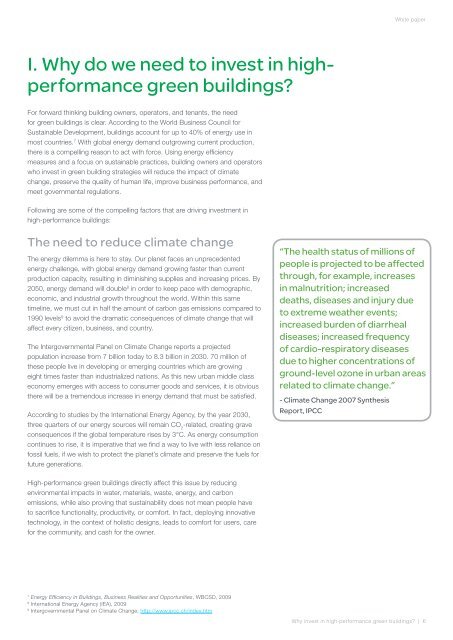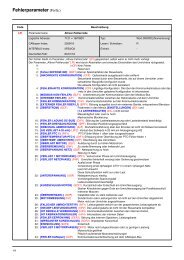Why invest in high-performance green buildings? - Schneider Electric
Why invest in high-performance green buildings? - Schneider Electric
Why invest in high-performance green buildings? - Schneider Electric
Create successful ePaper yourself
Turn your PDF publications into a flip-book with our unique Google optimized e-Paper software.
I. <strong>Why</strong> do we need to <strong><strong>in</strong>vest</strong> <strong>in</strong> <strong>high</strong><strong>performance</strong><br />
<strong>green</strong> build<strong>in</strong>gs?<br />
For forward th<strong>in</strong>k<strong>in</strong>g build<strong>in</strong>g owners, operators, and tenants, the need<br />
for <strong>green</strong> build<strong>in</strong>gs is clear. Accord<strong>in</strong>g to the World Bus<strong>in</strong>ess Council for<br />
Susta<strong>in</strong>able Development, build<strong>in</strong>gs account for up to 40% of energy use <strong>in</strong><br />
most countries. 7 With global energy demand outgrow<strong>in</strong>g current production,<br />
there is a compell<strong>in</strong>g reason to act with force. Us<strong>in</strong>g energy efficiency<br />
measures and a focus on susta<strong>in</strong>able practices, build<strong>in</strong>g owners and operators<br />
who <strong><strong>in</strong>vest</strong> <strong>in</strong> <strong>green</strong> build<strong>in</strong>g strategies will reduce the impact of climate<br />
change, preserve the quality of human life, improve bus<strong>in</strong>ess <strong>performance</strong>, and<br />
meet governmental regulations.<br />
Follow<strong>in</strong>g are some of the compell<strong>in</strong>g factors that are driv<strong>in</strong>g <strong><strong>in</strong>vest</strong>ment <strong>in</strong><br />
<strong>high</strong>-<strong>performance</strong> build<strong>in</strong>gs:<br />
The need to reduce climate change<br />
The energy dilemma is here to stay. Our planet faces an unprecedented<br />
energy challenge, with global energy demand grow<strong>in</strong>g faster than current<br />
production capacity, result<strong>in</strong>g <strong>in</strong> dim<strong>in</strong>ish<strong>in</strong>g supplies and <strong>in</strong>creas<strong>in</strong>g prices. By<br />
2050, energy demand will double 8 <strong>in</strong> order to keep pace with demographic,<br />
economic, and <strong>in</strong>dustrial growth throughout the world. With<strong>in</strong> this same<br />
timel<strong>in</strong>e, we must cut <strong>in</strong> half the amount of carbon gas emissions compared to<br />
1990 levels 9 to avoid the dramatic consequences of climate change that will<br />
affect every citizen, bus<strong>in</strong>ess, and country.<br />
The Intergovernmental Panel on Climate Change reports a projected<br />
population <strong>in</strong>crease from 7 billion today to 8.3 billion <strong>in</strong> 2030. 70 million of<br />
these people live <strong>in</strong> develop<strong>in</strong>g or emerg<strong>in</strong>g countries which are grow<strong>in</strong>g<br />
eight times faster than <strong>in</strong>dustrialized nations. As this new urban middle class<br />
economy emerges with access to consumer goods and services, it is obvious<br />
there will be a tremendous <strong>in</strong>crease <strong>in</strong> energy demand that must be satisfied.<br />
Accord<strong>in</strong>g to studies by the International Energy Agency, by the year 2030,<br />
three quarters of our energy sources will rema<strong>in</strong> CO 2 -related, creat<strong>in</strong>g grave<br />
consequences if the global temperature rises by 3°C. As energy consumption<br />
cont<strong>in</strong>ues to rise, it is imperative that we f<strong>in</strong>d a way to live with less reliance on<br />
fossil fuels, if we wish to protect the planet’s climate and preserve the fuels for<br />
future generations.<br />
High-<strong>performance</strong> <strong>green</strong> build<strong>in</strong>gs directly affect this issue by reduc<strong>in</strong>g<br />
environmental impacts <strong>in</strong> water, materials, waste, energy, and carbon<br />
emissions, while also prov<strong>in</strong>g that susta<strong>in</strong>ability does not mean people have<br />
to sacrifice functionality, productivity, or comfort. In fact, deploy<strong>in</strong>g <strong>in</strong>novative<br />
technology, <strong>in</strong> the context of holistic designs, leads to comfort for users, care<br />
for the community, and cash for the owner.<br />
7 Energy Efficiency <strong>in</strong> Build<strong>in</strong>gs, Bus<strong>in</strong>ess Realities and Opportunities, WBCSD, 2009<br />
8 International Energy Agency (IEA), 2009<br />
9 Intergovernmental Panel on Climate Change; http://www.ipcc.ch/<strong>in</strong>dex.htm<br />
White paper<br />
“The health status of millions of<br />
people is projected to be affected<br />
through, for example, <strong>in</strong>creases<br />
<strong>in</strong> malnutrition; <strong>in</strong>creased<br />
deaths, diseases and <strong>in</strong>jury due<br />
to extreme weather events;<br />
<strong>in</strong>creased burden of diarrheal<br />
diseases; <strong>in</strong>creased frequency<br />
of cardio-respiratory diseases<br />
due to <strong>high</strong>er concentrations of<br />
ground-level ozone <strong>in</strong> urban areas<br />
related to climate change.”<br />
- Climate Change 2007 Synthesis<br />
Report, IPCC<br />
<strong>Why</strong> <strong><strong>in</strong>vest</strong> <strong>in</strong> <strong>high</strong>-<strong>performance</strong> <strong>green</strong> build<strong>in</strong>gs? | 6

















